Day 390 - Rubens and Jan Bruegel collaborate
December 16, 2024
As I walk toward Gallery 613, the thought hits me that I usually make a beeline to the gallery that's my destination for the day, looking neither to the right nor to the left, and that this single-mindedness has led me to miss so much. It's rather late in the game, but I vow in my remaining visits to pause and look carefully at something that catches my eye en route. Since my habitual path to the Old Masters galleries involves a trek through a couple of very long galleries with changing exhibits of prints and photographs, I have scores, if not hundreds, of works from which to choose. Today one that catches my eye is a photograph by Alexander Rodchenko made in Moscow in the mid-1920s showing a middle-aged woman who sits isolated on the sidewalk selling cigars as city life swirls around her.
Gallery 613 takes as its theme the development of landscape painting in the 16th century. Perhaps inevitably, it's where Bruegel's "The Harvesters," the subject of Day 243's entry, has landed. The painting strikes me as smaller in format than I had remembered it, but no less monumental. A museum docent leading a Highlights tour pauses before it with her entourage. (I assume it's a Highlights tour because her next stop is "Aristotle Contemplating the Bust of Homer.") She's really very good, calling attention to some of the details in the painting and pointing out the way that triangles recur in the painting's composition. Despite the realistic details of the people depicted in "The Harvesters" (including, I note, the man in the foreground who is sprawled on the ground napping, his pants undone), the wall sign indicates that the sloping fields that fall away to the village in the distance are not to be found in the Netherlands.
The continuous landscape that forms the backdrop of a triptych by Joachim Patinir is even more fantastical. Behind what appears to me to be a reasonably realistic Flemish village, tall, craggy mountains arise - they're mountains never seen in nature, much less in Flanders. The triptych itself is rather interesting. The narrow panel on the left shows Saint John baptizing Christ, while the large central panel sdepicts Saint Jerome and the smaller panel on the right Saint Anthony. I'm a bit surprised that Christ doesn't occupy center stage. I pat myself on the back for identifying the other saints - although I've got Jerome and Anthony mixed up. Oh well, it's still pretty good for a non-Catholic.
In today's painting, landscape forms the background to a mythological subject, so realism isn't really the issue here. What made me choose this work, though, is not the landscape or the subject but the fact that it represents the collaboration of two celebrated artists, Peter Paul Rubens and Jan Bruegel the Elder. I would have thought that such collaborations were unusual, but the wall sign says that Rubens and Bruegel worked together on several mythological and religious paintings, showing off their respective skills. In this painting, entitled "The Feast of Anchelous" and made around 1615, it's pretty obvious who painted what. The scene shows Archelous, a river god (I assume that explains the blue mantle that has fallen from his shoulders) seated at a table in front of a rocky, vegetation-covered grotto and entertaining Theseus and his companions at a sumptuous banquet. The fact that this is a story from classical mythology gave Rubens a great excuse for painting nudes - both the well-muscled warriors and the soft, voluptuous women who serve them. The wall sign says that the figures are based partly on ancient sculptures, but I find myself wondering if Rubens knew Michelangelo's works, and a Google search indicates that he did. Bruegel did everything else, and I find myself especially admiring the skill with which he painted the glistening oysters, the lustrous silver and ceramic serving pieces, and the folds and shadows of the white tablecloth.
I wonder who commissioned this painting and where it originally hung - a dining room, maybe? I am unfamiliar with this Greek myth, but evidently, the painting's original owner was far more erudite than I.





Comments
Post a Comment